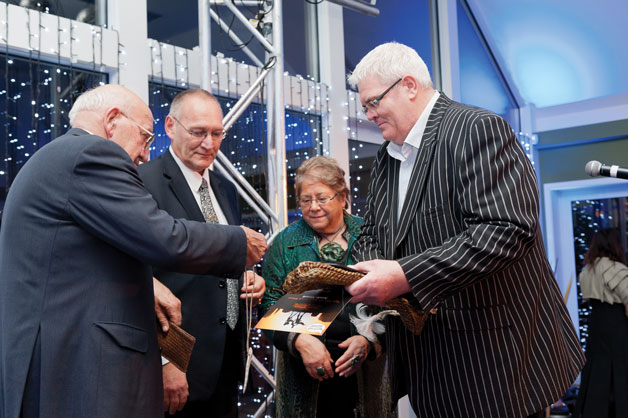A sense of pride
Jul 22, 2013


Tahu Potiki receives his Aoraki Matatū award from Tā Tipene O’Regan, Tā Mark Solomon and Ranui Ngarimu.
Photograph Alan Dove
Ngāi Tahu language leaders were recognised at a glittering awards ceremony at Ōtākou Marae that also honoured te reo heroes of the past.
In his opening speech, Tā Tipene O’Regan told the audience that the rebirth of Ngāi Tahu reo was in good hands. He said while previously the tribe had been consumed with the Claim, it was time to move on and promote revitalisation of Ngāi Tahu reo.
“As a people we’ve had a huge challenge in our part in the redevelopment of te reo,” he later told TE KARAKA. “In our history we had two whole generations effectively without native speakers. The business of recovering our culture and our ability to manage our own culture and our ability to manage the evolution of our culture requires te reo.”
This was the second time the Ngāi Tahu Reo Awards had been held.
Tahu Pōtiki received the top award of Aoraki Matatū for his lifetime commitment to te reo o Kāi Tahu; Komene Cassidy was named Taniwha Hikuroa for his contribution to te reo in Te Waipounamu; Lynne-Harata Te Aika received the Te Tautōhito award for leadership in teaching; Edward Ellison was awarded Te Puna o te Kī – Kāi Tahu kaumātua champion of te reo and Charisma Rangipunga won the Ruahine Crofts Award for excellence in te reo composition.
Paulette Tamati-Elliffe, programme leader of the tribe’s te reo strategy Kotahi Mano Kāika, Kotahi Mano Wawata, says the awards aim to celebrate and promote a sense of pride in what has been accomplished.
Kotahi Mano Kāika, Kotahi Mano Wawata literally means one thousand homes, one thousand aspirations. To date more than 1500 whānau including more than 4500 individuals have registered with Kotahi Mano Kāika.
Tamati-Elliffe says around 50 whānau use te reo Māori in their homes with their families. “There are a growing number of Ngāi Tahu whānau raising their tamariki in te reo, using te reo Māori as the first and natural language of communication in the home.”